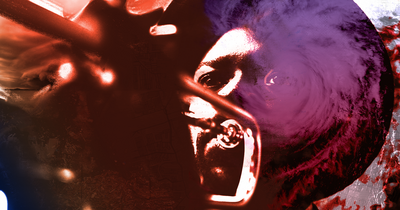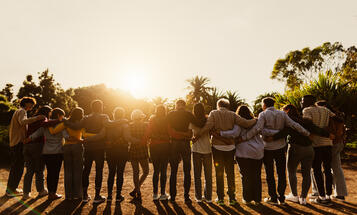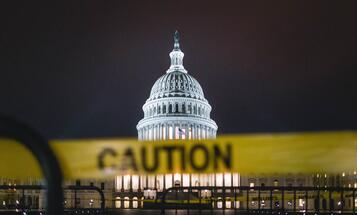
Amidst Multiple Storms of Injustice and the 15th Anniversary of Hurricane Katrina, the Fight for Climate Justice Continues
Communities face the same environmental and racial injustices they faced during Katrina—now with the overlapping crises of COVID-19, economic collapse, and uprisings for Black Lives. Policy change must address this.

This week, grassroots organizations of the Gulf South for a Green New Deal are commemorating the 15th anniversary of Hurricane Katrina by creating spaces for healing in community, honoring the lessons from recovery, and organizing to continue the fight for climate justice. But these events have been interrupted by Hurricane Laura, yet another climate catastrophe for the Black, brown, and poor communities of the region.
The Category 4 hurricane made landfall in Louisiana on Wednesday night. The heavy-hit region along the Louisiana and Southeast Texas coasts also happens to be pockmarked with petrochemical facilities in Black and brown neighborhoods. Fifteen years after Katrina opened a national conversation about racial inequality and disaster, these communities are still confronting the same environmental and racial injustices, made even more apparent in light of the interlocking crises of COVID-19, economic collapse, and uprisings for Black Lives gripping the country.
Memories of Hurricane Katrina bring back stark images of Black people stranded on rooftops, fighting for their lives, holding on to shreds of hope that help was on the way. Disaster then was met with a violent government response of neglect and even attacks on New Orleans’ Black community. Poor Black neighborhoods were left to fend for themselves while losing everything.
When Kanye West spoke on live television and proclaimed what many Black Americans were feeling at that time, “George Bush doesn’t care about Black people,” he uttered the quiet part out loud. It was a resounding truth that was felt by millions in that moment.
Today there are more white residents than Black residents in the city, which was not the case before [Katrina].
Many of these neighborhoods are still recovering 15 years later, and some have yet to be rebuilt. After Katrina, the people and city of New Orleans were left transformed. Today there are more white residents than Black residents in the city, which was not the case before the hurricane.
The city had a population of 455,000 before the storm, two-thirds of whom were Black; by 2010 there were 24,000 fewer white people and 118,000 fewer Black people residing in the city. According to the Political and Economic Research Council, nearly 1 in 4 Black-owned businesses had closed in 2008, which was a rate 52 percent higher than for white-owned businesses.
The eastern half of New Orleans, home to the now well-known Lower Ninth Ward, is where most of the extreme flooding occurred. This part of the city was home to many Black working-class, poor, and middle-class residents. These neighborhoods had their homes and businesses destroyed, and were essentially wealth-stripped, in the aftermath of this historic disaster.
Generations of violence against Black people in America, centuries of slavery, the Jim Crow era, and the decades of racist policies, like redlining, and displacement have relegated Black communities to geographically unsafe, inaccessible, polluted, and excluded neighborhoods all across the country.
In the face of Hurricane Laura and the COVID-19 pandemic disproportionately killing Black people, the failure of the U.S. government to protect Black people is clear, yet again, a result of centuries of racist policy design.
Hurricane Laura is sweeping through Cancer Alley, a swath of Louisiana mottled with industrial facilities.
Hurricane Laura is sweeping through Cancer Alley, a swath of Louisiana so mottled with industrial facilities that people who live there bear higher rates of respiratory diseases, cancer, asthma, and other diseases. Recently this area has become known as “Coronavirus Alley” because these same diseases have made the neighborhoods particularly vulnerable to contracting and dying from COVID-19. Black and Latinx communities are exposed to higher rates of pollution, and recent studies show communities that live with air pollution are at higher risk to COVID-19. Pollution inequality contributes to the wide disparity we now see as Black people in particular have contracted and died of COVID-19 at higher rates than white people. In an unequal society, the effects of disaster will always be borne unequally.
The impacts of crisis upon crisis are compounding, bringing death and disaster to neighborhoods that have been relegated as “sacrifice zones” in the United States. The connection between ongoing pollution and climate crisis was made visibly clear in Lake Charles, LA, when a hazardous fire broke out in a chemical facility in the aftermath of Hurricane Laura this week, spewing billows of toxic smoke into the surrounding neighborhoods.
The storm surge along the Louisiana coast was deemed “unsurvivable” by the National Weather Service this week, and we must ask, unsurvivable by whom?
The storm surge along the Louisiana coast was deemed “unsurvivable” by the National Weather Service this week, and we must ask, unsurvivable by whom? Who has the luxury to evacuate and who is left behind? The effects of storms we witness today are eerily reminiscent of when the levees broke, leaving Black families stranded on their rooftops and swimming up to their necks to survive.
We know the world will experience more frequent and intense climate impacts like storms, droughts, heat waves, and wildfires, and this now means communities most vulnerable are living in a perpetual state of disaster. Fifteen years after Hurricane Katrina, today’s violent disasters demonstrate that the racist policies that have produced racial inequality are deeply rooted. We must design policies that directly undo this racial injustice.
We must design policies that directly undo this racial injustice.
This means steering investments into communities most vulnerable—with targets like those the NY Renews coalition fought to include in New York’s climate change law. This means making sure federal investments in disaster preparedness and disaster response are equitably distributed to the most vulnerable. We must end discriminatory policies and economic disinvestment in Black communities that produce concentrated pollution and disaster inequality.
The vision for climate justice that groups like the Gulf South for a Green New Deal are fighting for includes building community wealth, supporting mutual aid and equitable disaster response, and a long-term vision of Black political empowerment. As frontline communities endure and recover from another storm, we must make real policies to reverse the ghettoization of neighborhoods that leaves them vulnerable to industry pollution, climate crisis, and public health disaster.




